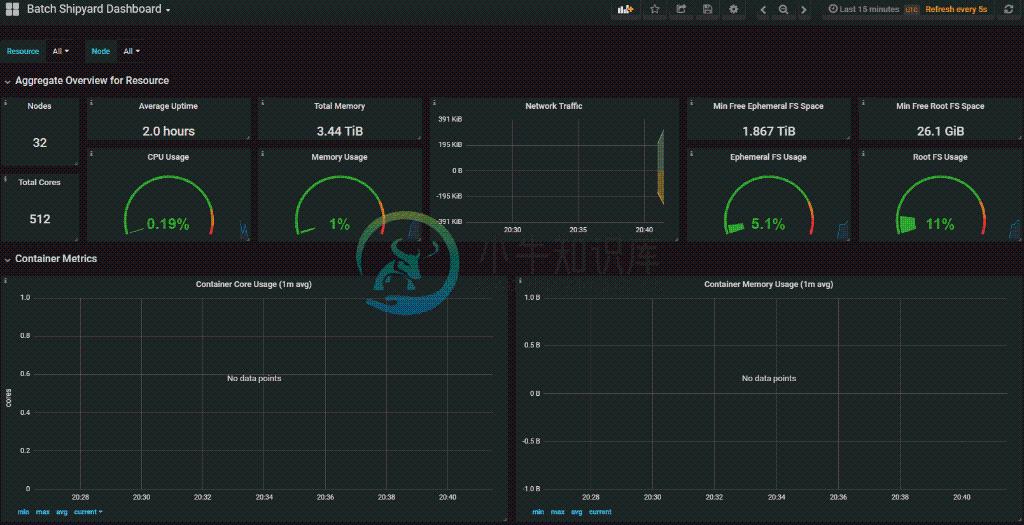Batch Shipyard
Batch Shipyard is a tool to helpprovision, execute, and monitor container-based batch processing and HPCworkloads onAzure Batch. Batch Shipyardsupports both Docker andSingularity containers. No experience with theAzure Batch SDK is needed; runyour containers with easy-to-understand configuration files. All Azureregions are supported, including non-public Azure regions.
Additionally, Batch Shipyard provides the ability to provision and manageentire standalone remote file systems (storage clusters)in Azure, independent of any integrated Azure Batch functionality.
Major Features
Container Runtime and Image Management
- Support for multiple container runtimes includingDocker, Singularity, andKata Containers tuned for Azure Batchcompute nodes
- Automated deployment of container images required for tasks to compute nodes
- Support for container registries includingAzure Container Registryfor both Docker and Singularity images (ORAS), other Internet-accessiblepublic and private registries, and support forthe Sylabs Singularity Library andSingularity Hub
- Transparent support for GPU-accelerated container applications on bothDocker and Singularityon Azure N-Series VM instances
- Transparent assist for running Docker and Singularity containers utilizingInfiniband/RDMA on HPC Azure VM instances includingA-Series,H-Series,Hb/Hc-Series,and N-Series
- Integrated support forSingularity Encrypted Containers
Data Management and Shared File Systems
- Comprehensive data movementsupport: move data easily between locally accessible storage systems, remotefilesystems, Azure Blob or File Storage, and compute nodes
- Standalone Remote Filesystem Provisioningwith integration to auto-link these filesystems to compute nodes withsupport for NFS andGlusterFS distributed network file system
- Automatic shared data volume support for linking toRemote Filesystems,Azure Filevia SMB, Azure Blobvia blobfuse,GlusterFS provisioned directly on compute nodes,and custom Linux mount support (fstab)
- Support for automated on-demand, per-job distributed scratch spaceprovisioning via BeeGFS BeeOND
Monitoring
- Automated, integratedresource monitoringwith Prometheus and Grafanafor Batch pools and RemoteFS storage clusters
- Support for Batch Insights
Open Source Scheduler Integration
- Support for elastic cloud burstingon Slurm to Batch pools with automatedRemoteFS shared file system linking
Azure Ecosystem Integration
- Support forserverless executionbinding with Azure Functions
- Support for credential management throughAzure KeyVault
Azure Batch Integration and Enhancements
- Federationsupport: enables unified, constraint-based scheduling to collections ofheterogeneous pools, including across multiple Batch accounts and Azureregions
- Support for simple, scenario-based pool autoscaleand autopool to dynamically scale and control computing resources on-demand
- Support for Task Factorieswith the ability to generate tasks based on parametric (parameter) sweeps,randomized input, file enumeration, replication, and custom Python code-basedgenerators
- Support formulti-instance tasksto accommodate MPI and multi-node cluster applications packaged as Docker orSingularity containers on compute pools with automatic job completion andtask termination
- Seamless, direct high-level configuration support for popular MPI runtimesincluding OpenMPI, MPICH, MVAPICH, and Intel MPI with automatic configurationfor Infiniband, including SR-IOV RDMA VM sizes
- Seamless integration with Azure Batch job, task and file concepts along withfull pass-through of theAzure Batch APIto containers executed on compute nodes
- Support for Azure Batch task dependenciesallowing complex processing pipelines and DAGs
- Support for merge or final task specification that automatically dependson all other tasks within the job
- Support for job schedules and recurrences for automatic execution oftasks at set intervals
- Support for live job and job schedule migration between pools
- Support for Low Priority Compute Nodes
- Support for deploying Batch compute nodes into a specifiedVirtual Networkand pre-defined public IP addresses
- Automatic setup of SSH or RDP users to all nodes in the compute pool andoptional creation of SSH tunneling scripts to Docker Hosts on compute nodes
- Support for custom host imagesincluding Shared Image Gallery
- Support for Windows Containerson compliant Windows compute node pools with the ability to activateAzure Hybrid Use Benefitif applicable
Installation
Local Installation
Please see the installation guidefor more information regarding the various local installation options andrequirements.
Azure Cloud Shell
Batch Shipyard is integrated directly intoAzure Cloud Shelland you can execute any Batch Shipyard workload using your web browser orthe Microsoft Azure Androidand iOSapp.
Simply request a Cloud Shell session and type shipyard to invoke the CLI;no installation is required. Try Batch Shipyard nowin your browser.
Documentation and Recipes
Please refer to theBatch Shipyard Documentation on Read the Docs.
Visit theBatch Shipyard Recipessection for various sample container workloads using Azure Batch and BatchShipyard.
Batch Shipyard Compute Node Host OS Support
Batch Shipyard is currently compatible with popular Azure Batch supportedMarketplace Linux VMs,compliant Linux custom images,and native Azure BatchWindows Server with ContainersVMs. Please see theplatform image supportdocumentation for more information specific to Batch Shipyard support ofcompute node host operating systems.
Change Log
Please see theChange Logfor project history.
Please see this project's Code of Conduct andContributing guidelines.
-
我开发了一个spring批处理,用于将用户加载到DB中。我能够从提供主类的eclipse中作为Java应用程序运行它,但不能通过unix服务器上的shell脚本运行批处理。我得到了这个例外: 我在job.xml文件中声明了bean,如下所示
-
您可以创建可执行的JAR文件,并使用Maven或Gradle命令运行Spring Boot应用程序,如下所示 - 对于Maven,您可以使用下面给出的命令 - mvn clean install 在“BUILD SUCCESS”之后,您可以在目标目录下找到JAR文件。 对于Gradle,您可以使用如下所示的命令 - gradle clean build 在“BUILD SUCCESSFUL”之
-
以下示例将演示如何使用Spring JDBC进行批量更新。 我们将在单个批处理操作中更新Student表中的可用记录。 语法 (Syntax) String SQL = "update Student set age = ? where id = ?"; int[] updateCounts = jdbcTemplateObject.batchUpdate(SQL, new BatchPre
-
以下示例将演示如何使用Spring JDBC进行批量更新。 我们将在单个批处理操作中更新Student表中的可用记录。 语法 (Syntax) String SQL = "update Student set age = ? where id = ?"; int[] updateCounts = jdbcTemplateObject.batchUpdate(SQL, new BatchPre
-
Batch Training Running algorithms which require the full data set for each update can be expensive when the data is large. In order to scale inferences, we can do batch training. This trains the model
-
分布式批量架构是解决复杂业务处理、数据分析、科学计算等耗时工作任务,这些任务被安排在特定的服务器上执行,被统一规划、拆分成子任务、统一调度、并发执行,大大提高了执行效率和可靠性,另外异步批量架构可以部署在网络内的任意服务器或PC上形成企业的云计算。 基本原理:举例说明异步批量的最基本原理,实际应用要比这复杂得多。比如:某企业要生成年终表报,并且年终报表要按照企业的各个部门、分公司出,报表的数据来源
-
这是一个企业级批次调度系统, 在成熟的spring框架基础上,实现ETL调度服务. 权限管理部分,采用asofdate hauth项目. batch-schduler与常见的任务调度系统侧重点不同,这个系统设计的初衷,是解决大批量存在依赖关系得任务调度。并不是为了解决定时任务调度。所以,batch-scheduler系统与通常的定时任务调度系统存在一些差异。 引用组件 spring-boot sp
-
SpringBatch,作为一个 Spring 组件,提供了通过使用 Spring 的 依赖注入(dependency injection) 来处理批处理的条件。下图是 Spring Batch 的体系结构


